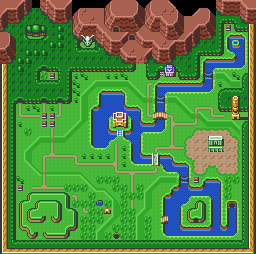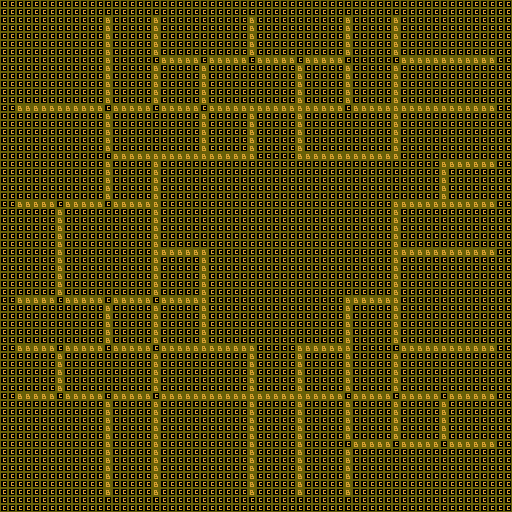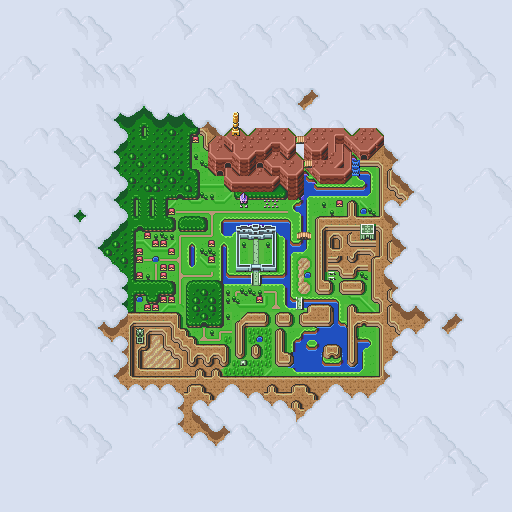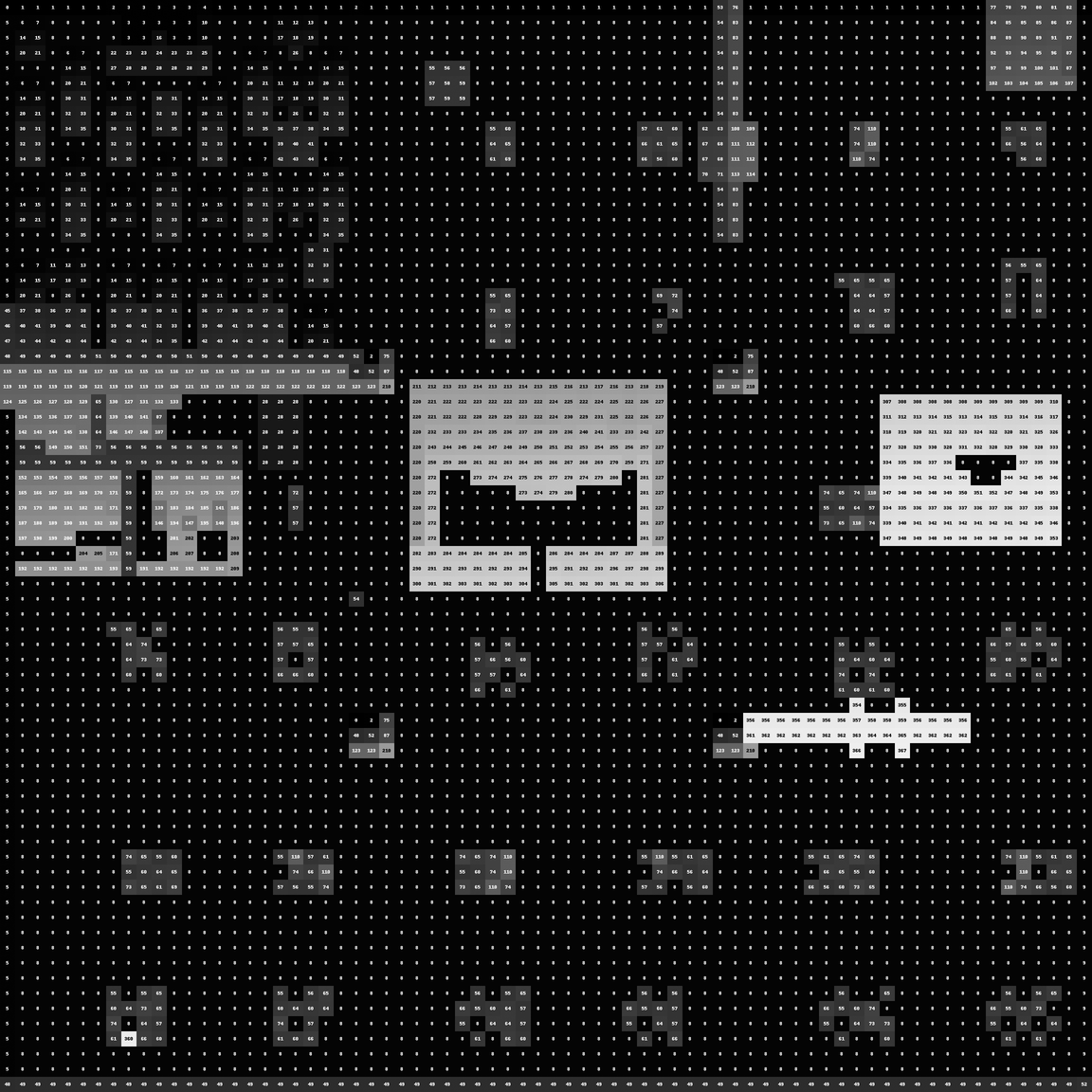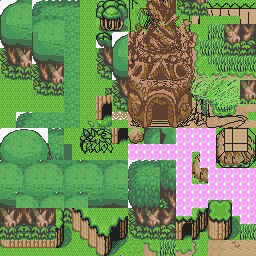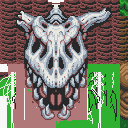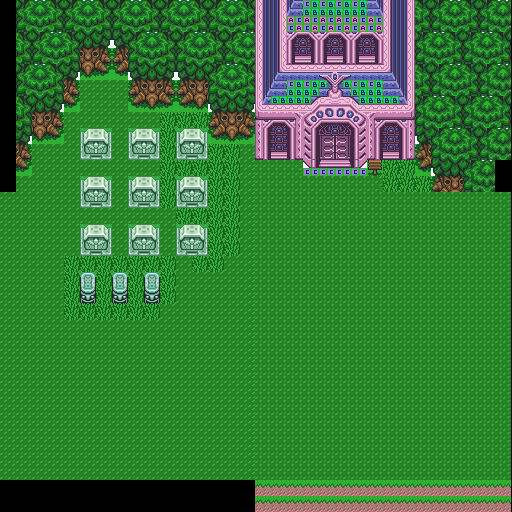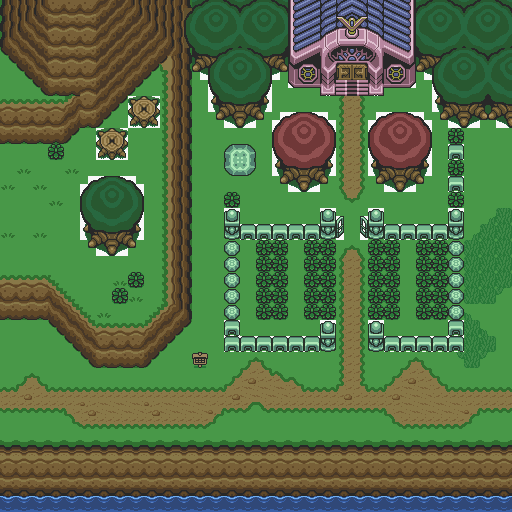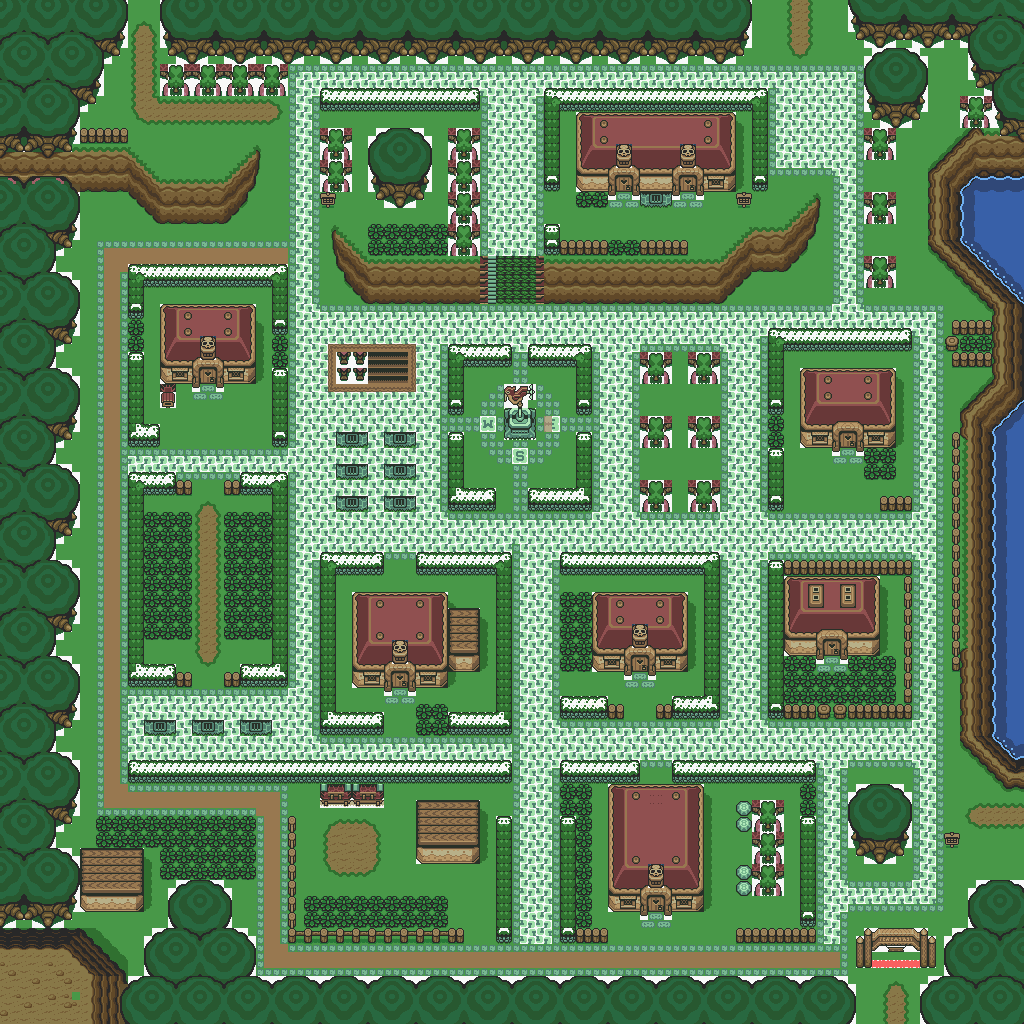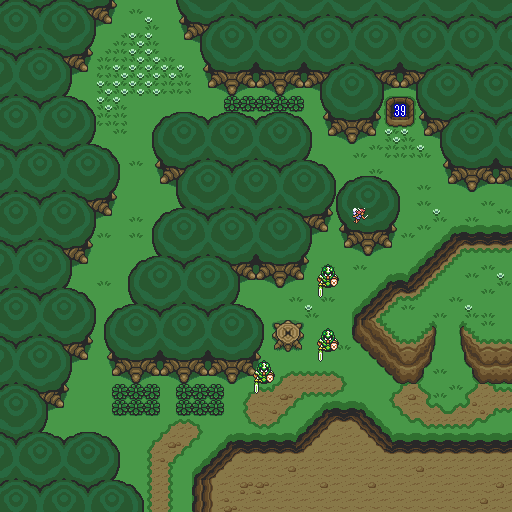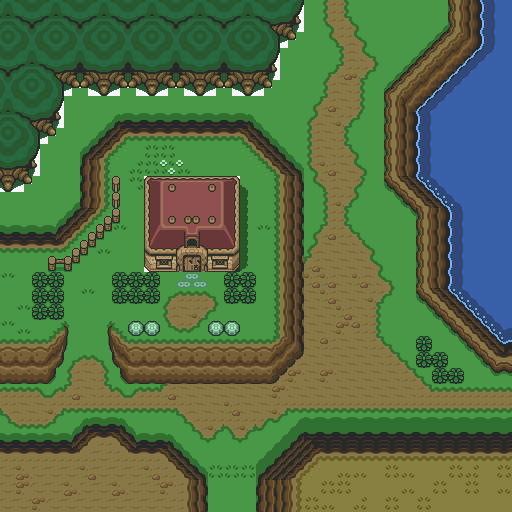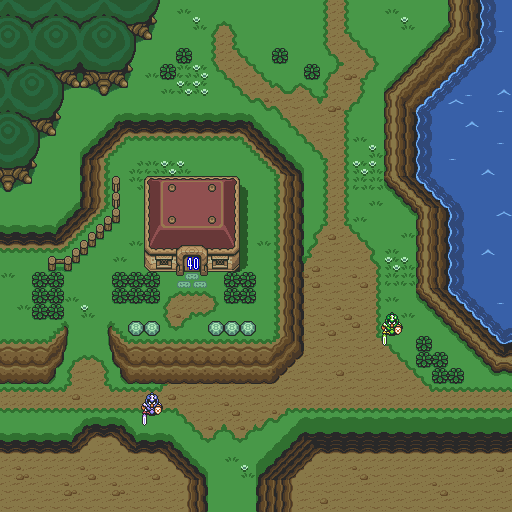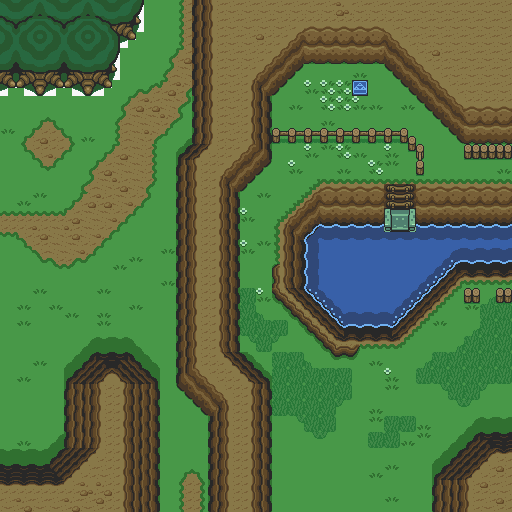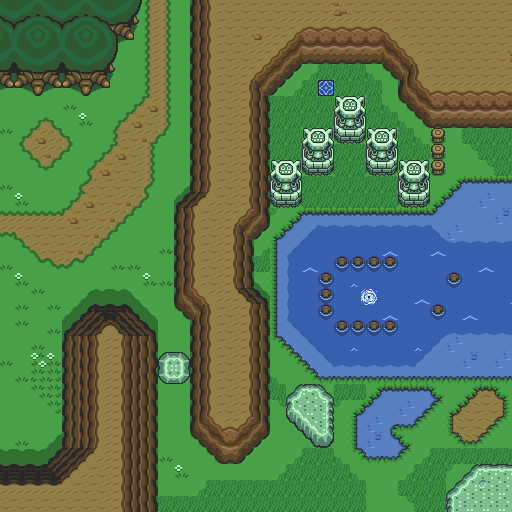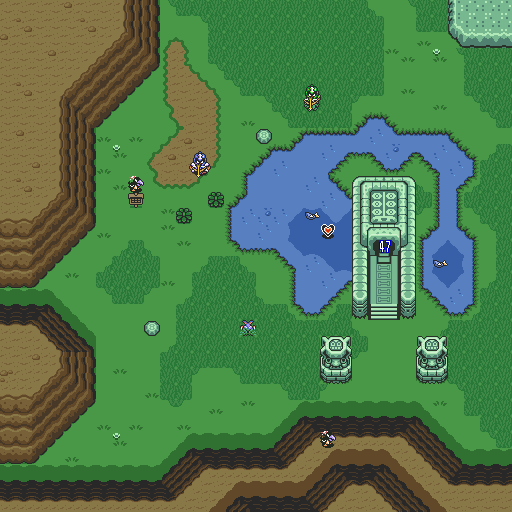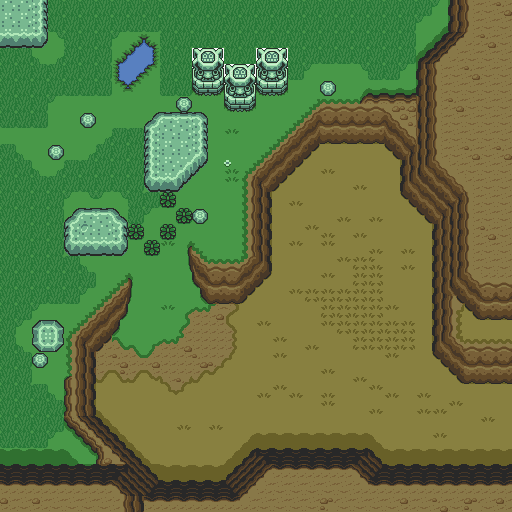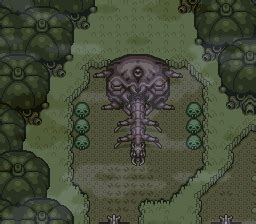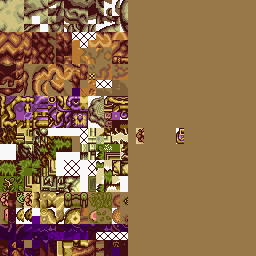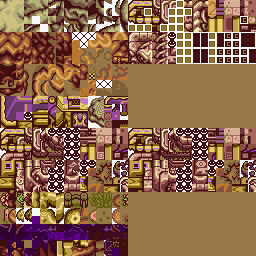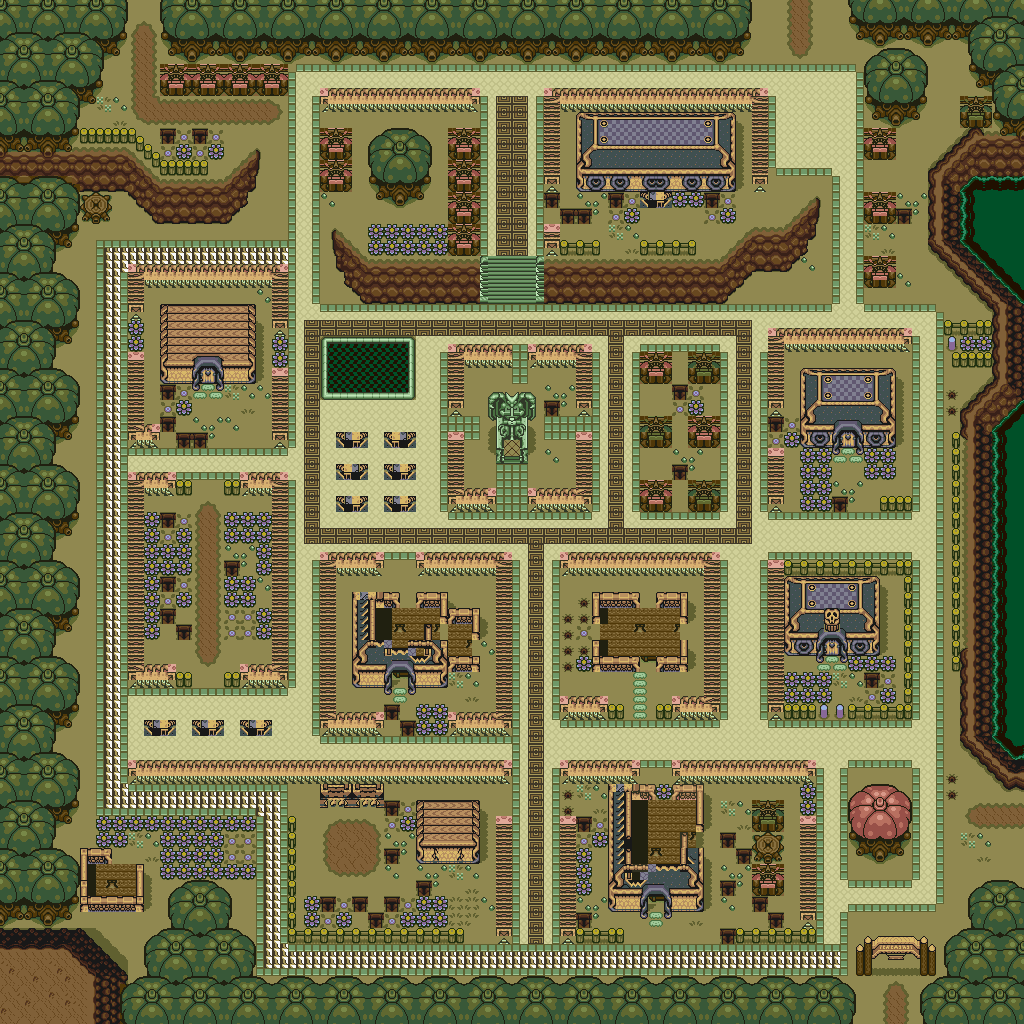If you appreciate the work done within the wiki, please consider supporting The Cutting Room Floor on Patreon. Thanks for all your support!
Development:The Legend of Zelda: A Link to the Past/Overworld
This is a sub-page of Development:The Legend of Zelda: A Link to the Past.
Attention: The dates below when prefaced by "Stamp:" reflect the file's internal date stamp that indicates which version of S-CG-CAD, an in-house image creation program used by Nintendo, that the .cgx, .col, and/or .scr files were last modified or opened by. They are used to create a rough organizational structure for this page and should not be interpreted as asset creation dates. Date information sourced from actual file last modified dates or other methods like correlation with code that was commented out are labeled as "Circa." For more information on file types and date information in the development content, see the metadata page.
Contents
- 1 World Maps
- 2 Light World
- 2.1 Early Mountains
- 2.2 Early 1990 Era Light Worlds
- 2.3 Lost Woods
- 2.4 Giant Skull
- 2.5 Master Sword Grove
- 2.6 East & West Death Mountain
- 2.7 Tower of Hera
- 2.8 Fortune Teller's Hut
- 2.9 Sanctuary
- 2.10 Graveyard
- 2.11 East of Graveyard
- 2.12 Witch's Hut
- 2.13 Zora Falls
- 2.14 Kakariko Village
- 2.15 Hyrule Castle
- 2.16 Bridge to Witch's Hut
- 2.17 Eastern Palace
- 2.18 Haunted Grove
- 2.19 Woods West of Link's House
- 2.20 Link's House
- 2.21 Bridge East of Link's House
- 2.22 The Desert of Mystery
- 2.23 Path from Swamp to Desert
- 2.24 Great Swamp Northwest
- 2.25 Great Swamp Sluice Gate Ruins
- 2.26 Great Swamp Southeast
- 2.27 Lake Hylia
- 3 Dark World
- 4 References
World Maps
These maps are similar to the map the player uses in the final game by pressing X, and are thus categorically distinct from environment assets that the player actually explores in the game by only being a representation of the environment assets in smaller form. They go back into 1990, and thus show rather significant changes from the final game. Some may or may not represent environments that were ever actually fully constructed. It is not certain, but the earlier ones may be mockup representations of the general look of what they were planning the environments to be like at any given point in time. Some are organized in such a way that would be difficult to represent fully in-game with the methods the game uses for camera scrolling, which could be an argument against some of them having been fully built. That is, until the guide maps from circa 1991, which are highly likely to have been built given the association with the available overdump prototype assets.
WM - Stamp: 1990-04
map.scr
| map.scr [S-CG-CADVer1.13 900424] |
|---|
Located in the same directory as map-1.scr, NEWS\テープリストア\NEWS_04\.\home\arimoto\DELDA\, map.scr is a very rudimentary world map.
Since map.scr was reconstructed later than map-1.scr, but in a similar manner to map-1.scr, it is useful to read the segment on how that overworld map was reconstructed first.
Owing to the lack of the map's unique .cgx tileset, an attempt was made at reconstructing it from the closest tileset still extant in the development files. Like fellow early Overworld, map-1.scr, only the .cgx tileset was changed, but not the map-defining .scr files themselves, so any attempt at reconstruction will never be perfect, just an approximation.
For example, map.scr seems to use tiles that don't exist in any other data for A Link to the Past, which is why large parts are either blank, or only contain blockset numbers and other placeholder data.
The notable areas are as follows:
- The massive "C", "E" and "SA?" areas are made up entirely of unique tiles. Nothing in these blocks repeat, which is highly unusual for these maps. These are likely placeholders for the island that would have held Hyrule Castle, the area surrounding the Eastern Palace. and the Sanctuary's surrounding areas respectively, if compared to their positions from the early 1990 overworld and other maps from this development time.
- The M area is an odd, unknown area, also using tiles that don't repeat. Speculating, it may be the Ruins spelled out on the the early 1990 overworld map, or the giant skull entrance in the smap files and other development files. It doesn't seem related to Death Mountain, despite the giant skull entrance being linked to it.
- The "1", "2", "4" and "8" tiles seemingly come down from Death Mountain, but there's no logical way to assemble tiles from the smap.cgx.bak tileset. Either there are major tiling errors, making it so the tiles won't align, or different tiles other than the ones available were used. However, these could just be evidence of a map quickly prototyped, lacking refinement, as there are tiling errors near the mouth of the river leaving Death Mountain, as well as an errant mountain tile on the east side, in the forest.
- The "F" and "H" tiles are hard to pin down. They could be any number of tiles, or even tiles that no longer exist in any tilesets at all.
- The area around tiles "6" and "7" is likely incorrectly arranged. The water edge's tiles work well in other parts of the map, but not here.
- Most of the top of Death Mountain is made up of one tile, leading to an unusual lack of detail. This is likely due to this being a quickly assembled, early map.
- It's uncertain if there is a desert in the south, but the tiles are the only ones who fit the structure of the area without rendering a ton of tiling errors. A swamp is feasible, due to one being in this area in the final game, but this would require far more swamp tiles than are available in any tileset. Since there has never been evidence for more and varied unique swamp tiles, it's safer to assume the desert existed here at one point.
- Lastly, we can't be certain that is, for sure, water infront of the taiboku in the upper left. Water was chosen to represent an area with unique tiles, different from the surrounding forest tiles. The idea of this being a pool of water is based on the taiboku scr, which, indeed, depicts a large pond infront of the faced forest.
WM - Stamp: 1990-06
smap.scr & smap1.scr
smap1.scr is one of the earliest maps known to exist from A Link to the Past's development. It provides a general outline of the map from the mid- to late-1990 era, with few key locations.
smap.scr is a slightly more developed version of smap1.scr from the same era. Now various notable locations, some not present in the final game, are represented.
| smap1.scr [S-CG-CADVer1.21 900611] | smap.scr [S-CG-CADVer1.21 900611] |
|---|---|
- A gold and pink iteration of Hyrule Castle can be seen in the center of the map, surrounded by a moat.
- The Eastern Palace can also be seen in its final game location. This dungeon persisted across much of development from early on, as its Japanese name and its graphical data are found in some of the game's earliest files.
- The Sanctuary and graveyard appear slightly to the east of where they appear in the final game to make room for what appears to be an entrance to Death Mountain which is not in that location in the final game.
- The Desert of Mystery is missing. In its place is a large, multi-tiered hill whose purpose is entirely unclear.
- There is a golden tower in the east of the map which may or may not have been the origin for the Tower of Hera.
- There's a giant skull at the base of Death Mountain. Further graphics for this can be found in this section.
- There's a clearing containing what associated files refer to as taiboku ("large trees" in Japanese), which stands far above any of the other trees in the Lost Woods. Further graphics for this can be found in this section.
- A strange island with a pool in it also exists in the northeastern corner of the map and no files yet uncovered point towards what this represents. It could be the genesis of an idea that did make it into the final game like the Mysterious Pond at the Waterfall of Wishing or Zora's River.
map-1.scr
| map-1.scr [S-CG-CADVer1.21 900611] |
|---|
This is a rather conservative reconstruction attempt for what map-1.scr from NEWS\テープリストア\NEWS_04\.\home\arimoto\DELDA\ could've looked like. The tile graphics for the map aren't present, and are likely lost, so the graphics shown here are purely for displaying the reconstructed map for research reasons. This doesn't reflect how it actually looked.
Tiles from the final were borrowed to make a custom tileset, with the palette used, map-1s.col, being edited to better match the borrowed tiles. The map-1.scr file itself is untouched.
However, as previously stated, this reconstruction is only for research purposes-- it will never be accurate to the map as it was originally designed. Because of this, there are errors, like the blank spaces where no compatible tile was found; such tiles may no longer exist.
Buildings and landmarks are chosen based on comparisons to both the final game's map, and other early overworlds we have available, but these may not be accurate or reflect how this map was initially designed. For example, the Tower of Hera might not have even been in its place, on the Northern summit of Death Mountain, at the time this map was created, but it was the closest tile that fit and exists there in other versions of the map.
smap2.scr & smap3.scr
| smap2.scr [S-CG-CADVer1.21 900611] | smap3.scr [S-CG-CADVer1.21 900611] |
|---|---|
These two maps show an idea that the developers might have been toying with, where unexplored areas of the map would be grayed out, and key locations were hidden from the player's view. A similar idea would be used in BS Zelda no Densetsu: Inishie no Sekiban, where any map areas outside of the current week's boundaries were covered over with clouds.
map-1a.scr
| map-1a.scr [S-CG-CADVer1.21 900611] |
|---|
This map is rendered with the reconstructed map-1.scr CGX tileset. It's about the same as that map, too, but seems to be graying out unexplored areas like the past two maps were.
However, a detail noticed by GlitterBerri, is that the highlighted space is larger than the ones in the previous two smap2 and smap3 maps. This might indicate where the developers expected the player to go, and in a way reflecting the story, at the time this map was created. However, that is not certain, and it could just be random developer choice too.
map-kage1a.scr
| map-kage1a.scr [S-CG-CADVer1.21 900611] |
|---|
The name of this file translates to map-shadow1a.SCR. It seems to be directly related to map-1.SCR, and more particularly, map1a.SCR, which can be seen by overlaying it on top of them.
| map-1.scr with map-kage1a.scr |
|---|
It is highly likely that the borders represent map divisions that determine how the screen scrolls when Link travels between map squares.
| map-1a.scr with map-kage1a.scr |
|---|
The open area depicted in map-kage1a.SCR is almost identical to the highlighted area in map1a.SCR, save for the upper-right area containing the river up to the lake with the island. Here, there are two sets of two rows of dark-coloured Cs which partly overlap the highlight: one set at a riverbend and one at the bottom of the lake region.
WM - Circa: 1991-05
smap7.scr.bak
| smap7.scr.bak |
|---|
This surface map was found within the source data[1] in a hexadecimal-based format, different from the typical .scr files that are in the developer workspace data. Here, it was converted into a usable .scr file. In addition, it could be perfectly reassembled with the available graphics data for these types of maps within the overdump prototype's data. Because it was found in this hexadecimal-based format, no S-CG-CAD timestamp was found in the file.
Judging by the locations and structures present on the map, it is much closer to the overdump build's surface map and the final game's surface map than the other maps from other developer workspaces, but still provides a valuable look at a transitional period from where the game was closer to the final map.
Because there is no reliable date data associated with smap7.scr.bak, the question may come up with these following maps: Which is earlier in development, smap7.scr.bak or the "Super Donkey" overdump build's smap?
| smap7.scr.bak, unknown date | Overdump map, mid-1991 | Final Game, late 1991 |
|---|---|---|
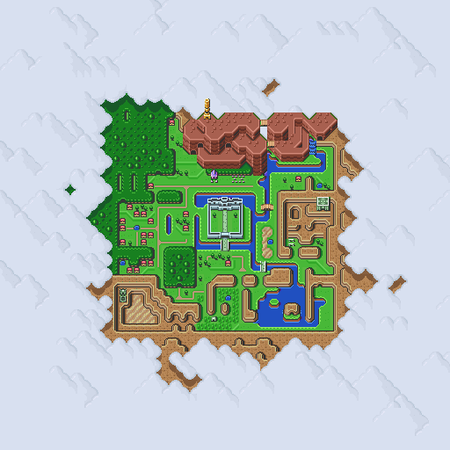
|

|

|
Here we will attempt to solidify a timeline of the development of A Link to the Past by comparing two hypotheses about how two similar yet distinct early maps are in development. Since we do not have a date for smap7.scr.bak, we will compare how much details match between each map to the final map.
Hypothesis A is that Super Donkey's map is from earlier in development than smap7.scr.bak:
- A1. The castle courtyard is larger in both smap7.scr.bak and the final, whereas the Super Donkey's map shrinks the castle courtyard along the north-south axis.
- A2. In Super Donkey's map, a unique house graphic is used for the witch's shop, but both smap7.scr.bak and the final game use a normal house graphic.
Hypothesis B is that smap7.scr.bak is from earlier in development than Super Donkey's smap:
- B1. The triple angular ledges on the left side of Death Mountain are a closer match between Super Donkey's map and the final game, whereas these ledges in smap7.scr.bak are rather different.
- B2. The three tree formation left of Kakariko Village is identical between Super Donkey's map and the final game, whereas it is slightly different in smap7.scr.bak. The nearby clouds, forming the map's border, also mirror the final's design, but are different in smap7.scr.bak.
- B3. To the east of Hyrule Castle, there is land separating two halves of the river in both Super Donkey's map and the final. Smap7.scr.bak lacks this feature.
- B4. In smap7.scr.bak, there is a pond in the race area below Kakariko Village. Both the overdump and the final game lack a pond in this area. Notably, it appears that, prior to April, soldiers were replaced by the race game NPCs,[2] necessitating a change in the map's design.
- B5. Desert Palace, while by no means close to the look of the final in either Super Donkey's map or smap7.scr.bak, has its main entrance closer to where it is in the final in Super Donkey's map. It is instead on the far western edge of the desert in smap7.scr.bak.
- B6. The location of Venus' cave in Lake Hylia in Super Donkey's map is closer to where it is in the final, while smap7.scr.bak places it a tiny bit further south. The eastern land formation near the Ice Rod cave is closer to the final game in shape in Super Donkey's map.
- B7. The biggest giveaway that Super Donkey's is later than smap7.scr.bak's map, is that the unreachable mountains forming the southern border of the map use a different formation in the smap7.scr.bak, but are identical to the final's in Super Donkey's map. At least, it's more likely than changing the mountains from Super Donkey to smap7.scr.bak, and reverting to an earlier iteration for the final game.
- B8. The last telltale sign, though it's hard to see without directly comparing the maps side by side, is that in Super Donkey's map, both Kakariko and the Desert of Mystery are larger than smap7.scr.bak's map, expanded by a tile's width on the western side of each. The southern edge of the map has also been expanded downward in both Super Donkey's and the final game, when compared to smap7.scr.bak. This would, again, make it so they had to redesign both edges of the map, as mentioned in B2 and B7.
The sheer amount of evidence lends support to smap7.scr.bak being earlier than Super Donkey's map, being different from the final in many key areas.
There are potential reasons that changes made in A1 and A2 would have been reverted to smap7.scr.bak's state for the final. Trying out a smaller castle courtyard in Super Donkey's map to allow for more environment elsewhere may not have worked out how the developers liked, or caused awkward screen scrolling issues due to the way the game has to pause any action and scroll along Link's direction at specific points on the overworld. Removing the added unique look of the witch's shop on Super Donkey's map would be a compromise, allowing them to save on tile space and add another unique tile, while a normal house would be enough for the player to know there is something noteworthy there.
On the other hand, B2 and B7 are such minor details that it wouldn't make sense to revert them for the final game, if it was, indeed, the earlier map.
Light World
The overworld design assets for key areas like the area around Eastern Palace, Death Mountain, Lake Hylia or Hyrule Castle are divided into numbered areas, each made up of 4 smaller quadrants that when merged form a larger whole. An example of how these are named in the data is Eastern Palace's environments, which are named 6a.scr, 6b.scr, 6c.scr, and 6d.scr for example. Smaller areas that don't merge into quadrants have file names beginning with "s", then a sequential number, and then their file extension. For example, s19.scr is the Haunted Grove.
Early Mountains
EM - Stamp: 1989-11
| osr-st-ym-2.scr [S-CG-CADVer1.10 891115] |
|---|
Early 1990 Era Light Worlds
LW1 - Circa: Early 1990
The source code file 日本_Ver3/asm/z00_mpdt.asm is an alternate version of zel_mpdt.asm, which is described in the next section. It defines 54 MPDAT[xx] labels, where [xx] is a decimal number from 00 to 261. The labels seem to be arranged in pairs, as seen in the truncated example of the file's global definitions below.
GLB MPDAT00,MPDAT01
GLB MPDAT10,MPDAT11
GLB MPDAT20,MPDAT21
GLB MPDAT30,MPDAT31
[...]
GLB MPDAT90,MPDAT91
GLB MPDAT100,MPDAT101
GLB MPDAT110,MPDAT111
[...]
GLB MPDAT260,MPDAT261
Each label contains 36 rows of 8 hexadecimal words. These may correspond to the 32x32 pixel metatiles (graphical units comprised of four 16x16 metatiles, which are themselves comprised of four 8x8 tiles, the smallest graphical unit in the game) that are used to build the overworld.
MPDAT00 EQU $
WORD 00000H,00001H,00001H,00001H,00001H,00001H,00001H,00002H
WORD 00003H,00003H,00003H,00003H,00003H,00004H,00001H,00001H
WORD 00001H,00001H,00001H,00001H,00001H,00001H,00001H,00002H
;
WORD 00005H,00006H,00007H,00008H,00008H,00008H,00008H,00009H
WORD 00003H,00003H,00003H,00003H,00003H,0000AH,00008H,00008H
WORD 00008H,00008H,0000BH,0000CH,0000DH,00008H,00008H,00009H
;
[...]
If one converts this data into pure hexadecimal numbers by removing the leading zero, the text, and other non-numeric characters, and then visualizes the resulting hex using a utility called TiledGGD using the settings displayed in the file description, it is possible to generate the following image, which looks suspiciously similar to other early overworld maps.
The reason there are three copies of the overworld may relate to the fact that there were originally going to be three overworlds in the game.
• This game has a light world and a dark world. When did you decide on that sort of duality?
Miyamoto: At first there were 3 worlds, but players would’ve gotten confused. That’s why we had to fix things up. It’s difficult to plant a new concept like that in an action game, you see.
Tezuka: In that regard, Nakago was very realistic. He was saying from the start that we wouldn’t be able to make 3 worlds.
Nakago: I ended up just making one, but it was split into two and reborn.
The file has a date of "1990.01.19(FRI)" at the top, but this is likely simply the date that it was created, meaning that the data within may have continued to be modified over time. Thus, it's difficult to know exactly when the content is from and there's no guarantee of which of the early 1990 overworlds in this section is the earliest.
CDi-Fails created the image below by interpreting the data that seems to make up the first overworld as a tile map that would contain 32x32 metatiles represented by numbered squares.
LW2 - Circa: Early 1990
The source code file 日本_Ver3/asm/zel_mpdt.asm is an alternate version of z00_mpdt.asm, but contains more data than the former, suggesting that it may be a later revision. It defines 256 MPDAT[xxx] labels, where [xxx] is a hexadecimal number from 000 to 7F1. The labels seem to be arranged in pairs, as seen in the truncated example of the file's global definitions below.
GLB MPDAT000,MPDAT001
GLB MPDAT010,MPDAT011
GLB MPDAT020,MPDAT021
GLB MPDAT030,MPDAT031
[...]
GLB MPDAT0E0,MPDAT0E1
GLB MPDAT0F0,MPDAT0F1
;
GLB MPDAT100,MPDAT101
GLB MPDAT110,MPDAT111
[...]
GLB MPDAT7F0,MPDAT7F1
Each label contains 16 rows of 8 hexadecimal words. These words may correspond to the 32x32 pixel metatiles (graphical units comprised of four 16x16 metatiles, which are themselves comprised of four 8x8 tiles, the smallest graphical unit in the game) that are used to build the overworld.
In the final game, map squares are sixteen 32x32 metatiles high, and sixteen 32x32 metatiles wide. As such, each pair of labels in zel_mpdt (for example, MPDAT000 and MPDAT001) appears to comprise the upper and lower halves of one map square, meaning that this version of the overworld would be 6 map squares by 6 map squares. The final overworld is 8 map squares by 8 map squares.
MPDAT000 EQU $
WORD 00000H,00001H,00001H,00001H,00001H,00001H,00001H,00002H
WORD 00003H,00003H,00003H,00003H,00003H,00004H,00001H,00001H
[...]
If one converts this data into pure hexadecimal numbers by removing the leading zero, the text, and other non-numeric characters, and then visualizes the resulting hex using a utility called TiledGGD using the settings displayed in the file description, it is possible to generate the following image, which looks suspiciously similar to other early overworld maps.
Like z00_mpdt.asm, zel_mpdt.asm also has a date of "1990.01.19(FRI)" at the top.
CDi-Fails created the image below by interpreting the data that seems to make up the first overworld as a tile map that would contain 32x32 metatiles represented by numbered squares.
LW3 - Stamp: 1990-04
| OSR-ST - 1a-9d.scr.bak [S-CG-CADVer1.12 900404] |
|---|
Credit to the Delda group for assembling this extremely early prototype overworld from the OSR-ST folder. It's notable that the developers created "Work in progress" signs to point out where some assets have yet to be added. Even at this early stage, facets of the final map are noticeable: a lake in the lower-right corner, Hyrule Castle situated in the center with a river running past it creating a moat, and the upper-left corner of the map being more heavily forested. It is uncertain if the cave systems were planned to lead anywhere at this point, but several caves in the top-left are unreachable unless cave systems were to connect to them from the bottom-left of the map.
It seems likely this overworld was abandoned when the graphical style was later changed to move closer to what we know as the final art style of the game, but facets of its design persist into the final map.
Interestingly, the word "ruins" (遺跡 iseki) in Katakana can be seen spelled with trees at the top-middle of the map.
Lost Woods
LW - Stamp: 1990-04
| hmori1.CGX.BAK | hmori2.CGX.BAK | hmori3.CGX.BAK |
|---|---|---|
| hyrl-3.CGX.BAK | hyrl-4.CGX.BAK | hyrl-A.CGX.BAK |
Early forest sketches, some of the earliest assets in still extant prototype material, all having the metastamp S-CG-CADVer1.13 900424. Some of the sprites include more detailed tree clump sprites, like those spotted in the 1990 Overworld.
| h-6.scr [S-CG-CADVer1.13 900424] |
|---|

|
A rather early, unfinished, rough draft of the large tree area, but mocked up with simpler assets. Its metastamp lends credence to this being a really early asset.
| mori1.scr [S-CG-CADVer1.13 900424] |
|---|

|
What appears to be an incredibly early iteration of the southern Lost Woods entrance, with three entrances and paths beyond those entrances. Requires SCAD to view, and still contains errors, like the top of the image looping around the bottom. Given its metastamp of S-CG-CADVer1.13 900424, it's amongst some of the earliest assets in the game.
| taiboku.scr [S-CG-CADVer1.13 900424] |
|---|

|
A forest clearing with a large, faced tree (translated from the Japanese "taiboku") flanked by two smaller, faced trees on either side, a pool of standing water before them. This scr file is clearly in an unfinished state, but gives an idea of what the designer intended for this area. It appears in the early overworld maps, in the upper-left corner with the Lost Woods, roughly where the Master Sword is in the final game. It's not possible to discern what role this area would've played in that event at this stage in the game.
The trees with faces concept would take root in the final game, with fully featured Dark World trees.
LW - Stamp: 1990-06
| 6-2.scr [S-CG-CADVer1.21 900611] |
|---|
A transitional area, designed between the early 1990-era overworld and the 1991 overworld. This is an extremely rough stage of an unseen Lost Woods design. It is beset by tiling errors, either because the graphics file referenced is not correct, or because the file's format contains differences compared to what the viewer software expects, or because it was never finished. Given the metastamp date of S-CG-CADVer1.21 900611, it fits with the era of the smap.scr overworlds.
LW - Stamp: 1990-12 & Circa 1991-05 to 1991-08
| Tanabe Folder: Overworld Area 1 - Lost Woods |
|---|
The Lost Woods area as retrieved from the Tanabe folder. The upper two screens have modified dates of 08-18-1991. The lower two screens, which are noticeably further from the final and have more tiles that appear out of place, are older than 05-23-1991 but the date they were last modified is not older than 12-26-1990, the date of their S-CG-CAD metastamp of S-CG-CADVer1.23 901226. The thieves' dens found in the final are not in either portion of the map, but one can see they were at some point planned in the CGX graphics files used for the area.
It is likely that the out of place tiles correspond to pieces of the CGX tileset that were originally different but had not yet been updated in the actual environment file seen here to look correct.
There is also a different, older version of the upper-left corner of the woods in the Yamada folder seen here. It contains similar issues to the older lower screens in the Tanabe folder and has the same modified and metastamp dates as those quadrants:
Giant Skull
GS - Stamp: 1990-12
| hone.cgx [S-CG-CADVer1.23 901226] |
|---|
A giant skull formation in front of a sheer mountainside. This formation is visible from the early overworld maps, and is accompanied by some preliminary sketches, which is somewhat common in the material in Arimoto's development workspace. The formation may be a dungeon or cave system entrance. It's worth mentioning that this formation is present on the earliest Light World maps of A Link to the Past and thus is not a Dark World formation alone. Since the prototype content does not have Dark World maps from this early in development, it is unclear whether the formation would be the same in the Dark World, be entirely different, or if the Dark World was even conceived at this point in development.
There is an earlier version of this formation with the filename hone.CGX.BAK with a metastamp of S-CG-CADVer1.21 900611 as well, indicating it was going through development much earlier, as expected by its inclusion in the early world map files.
Master Sword Grove
MS - Stamp: 1990-12
| Early Master Sword Grove - m-1.scr [S-CG-CADVer1.23 901226] |
|---|
| The Master Sword Grove - m-1.scr.bak [S-CG-CADVer1.23 901226] |
| Unused Grove Component - m-2.scr [S-CG-CADVer1.23 901226] |
The Master Sword Grove is present in the workspace data very close to how it appears in the final game - there are actually several copies of it in multiple folders with few variations. A tiling error instead of the flowers on the ground is the most common variation and also contains an unfinished version of the sword's platform, which can be seen in the first picture above. The area underneath the bridge is also a component of this screen, most likely just because both are areas just off from the main world map and it saves space to merge them.
What is unusual, however, is the m-2.scr environment file which is found with the source. It contains no Master Sword pedestal and merely ends at its northern-most point. What it was a remnant of or what purpose it may have had is unclear.
East & West Death Mountain
DM - Stamp: 1990-12 & Circa 1991-07
| Tanabe Folder: Overworld Areas 2 and 3 - East and West Death Mountain |
|---|
An extremely early version of both eastern and western halves of Death Mountain. The two screens on the upper right, which bear a different palette, are relatively newerthan the others, with a last modified date of 07-22-1991. The rest of the files, western Death Mountain and the bottom of eastern Death Mountain, have metastamps of S-CG-CADVer1.23 901226, placing their creation after that date, but before 05-23-1991.
One thing these maps reveal is that Death Mountain went through a redesign phase in early 1991, and maybe before if the early world maps are any indication, where the mountain summit was unreachable to the player. The top-leftmost screens best show this development phase, especially when contrasted against the cloudy right side. By this time, around 07-22-1991, Death Mountain had moved to the "cloudy" Death Mountain phase, as seen in the final game, where the player can near the summit and see the clouds below.
As for how Link was meant to access the Tower of Hera during this phase, the Warp Tile hints that the player needed to hop back and forth between worlds, climbing the mountain between both sides. The cave system could also have been used to traverse the mountain, too, but this is all speculation.
These maps existing in the Dark World hint that Ganon's Tower might have been where the Tower of Hera lies in the Light World. There is data for the entrance to Ganon's Tower in arimoto\zelda\d, with files d8-1.scr and d8-h.scr, but these files also predate the development of Ganon's Tower by quite some time.
It's also unclear where Turtle Rock fits in in this phase of development, because both Light and Dark World screens associated with it are missing, though the graphics for the Turtle exist.
| Tanabe Folder | Final |
|---|---|
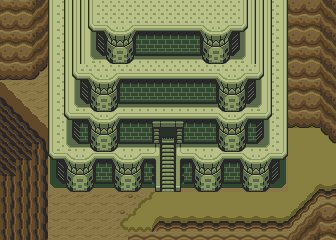 |
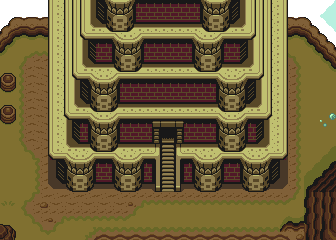 |
DM - Circa: 1991-10
| 7.cgx [10-23-1991] |
|---|

|
An extremely enigmatic version of the Death Mountain graphic sheet, containing:
- Sketches of large crystals.
- Variations on the Dark World warp tile's animation.
- A niche in a mountainside graphic that looks fit for being inlaid with a crystal or Rupee-shaped object, as well as a more circular niche.
- Most puzzling of all, statues bearing Link's likeness along with posts with the likeness of the Triforce.
What exactly the statues and the crystal-shaped niche were to be used for will likely never be known for certain unless more information comes to light.
Tower of Hera
TH - Circa: 1991-10
| 7-1.cgx 10-23-1991 | Final |
|---|---|
 |
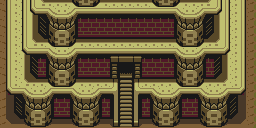 |
An alternate Tower of Hera graphic which seems to go unused even in the 1991 prototype Death Mountain environment. Exists in the raw graphics data fully assembled.
Fortune Teller's Hut
FL - Stamp: 1990-12
| s6.scr [S-CG-CADVer1.23 901226] | Final |
|---|---|
Sanctuary
SA - Stamp: 1990-04
| 8.MAP [S-CG-CADVer1.13 900424] | Final |
|---|---|
A very early version of the Sanctuary map. Like early versions of the world map, such as the one below, it depicts the graveyard as being located left of the church and occupying the same map square. (An early design document also explicitly ties the church to the graveyard.)
As with the early .MAPs of Lake Hylia, this .MAP has numerous graphical errors when viewed in either the 2003 version or the contemporary version of Nintendo's graphics editing program found in the Gigaleak without major tweaking. There are multiple possible reasons for why this might be, including the following.
- The format of the .PNL and .MAP files may differ from the format that the program in the Gigaleak expects because the developers later made tweaks to it. This renders them incompatible or not entirely compatible with the versions of the program available via the Gigaleak.
- This appears to be the case regarding the file format of (some?) of the OBJ files found in the Gigaleak.
- The files may work correctly if the proper .MAP, .PNL, and .CGX file are used together, but exact combinations no longer exist.
One prominent error is that some .MAP files are segmented in two, with the two halves arranged on the opposite side from where they should be. (This includes 8.MAP, whose halves were rearranged using image-editing software following restoration.) Another is black patches on the .MAPs, which don't appear to be fixable regardless of how the .PNL files used with them are modified.
Restoration of the .MAP to its current state was performed using a modified .PNL reconstruction technique in which the contents of a .PNL file from a similar era were reorganized so that tile formations were positioned in such a manner that they worked properly in conjunction with the .MAP.
While the Lake Hylia .MAP restorations only required moving existing formations within a .PNL file from a similar era, reconstructing the Sanctuary, tombstones, and stone faces required transplanting graphical resources from three other .CGX files in addition to the base .CGX file used with the .MAP and .PNL to correct the landscape portions of the image (such as the trees and grass).
Despite the complexity of the process involved, because of the way that .MAP and .PNL files interact, the result is more than mere guesswork. A single modified .PNL from this era can be used with multiple .MAP files without overlaps seeming to occur, suggesting that the .MAPs from this era were constructed in such a way that they could be used with a single .PNL file.
The .CGX file used for the Sanctuary predates the era of the other .CGX files. However, it was used because it has a Sanctuary pre-assembled inside that could be used as a model for reconstruction, one whose dimensions and layout were identical to those of the structure in the .PNL and .MAP file. (Unfortunately, the pre-assembled Sanctuary does not include the roof portion, applicable tiles for which seem to be missing from every extant .CGX file.) Additionally, graphical assets for a nearly-identical Sanctuary can still be found in files from the era to which the other .CGX files, the .MAP, and the .PNL belong.
SA - Stamp: 1990-12
| s8.scr [S-CG-CADVer1.23 901226] | Final |
|---|---|
A version of the Sanctuary outdoors with few differences from the final game besides an additional sign and the missing descending underground cave.
Graveyard
GY - Stamp: 1990-12
| s9.scr [S-CG-CADVer1.23 901226] | Final |
|---|---|
East of Graveyard
EG - Stamp: 1990-12
| s10.scr [S-CG-CADVer1.23 901226] | Final |
|---|---|
Witch's Hut
WH - Stamp: 1990-12
| The Witch's Hut - s11.scr [S-CG-CADVer1.23 901226] |
Final |
|---|---|
The Witch's Hut is more of a basic cabin at this stage, and an earlier iteration of the world transition tile is nearby, blocked by Hammer pegs - very notable since there isn't a world transition tile here in the final game. At this stage in development, they seemed far more open about showing the player these tiles out in the open. In contrast, in the final game, most are hidden under rocks or in out-of-the-way areas.
Zora Falls
ZF - Stamp: 1990-12
| t-1.MAP [S-CG-CADVer1.23 901226] | Final |
|---|---|
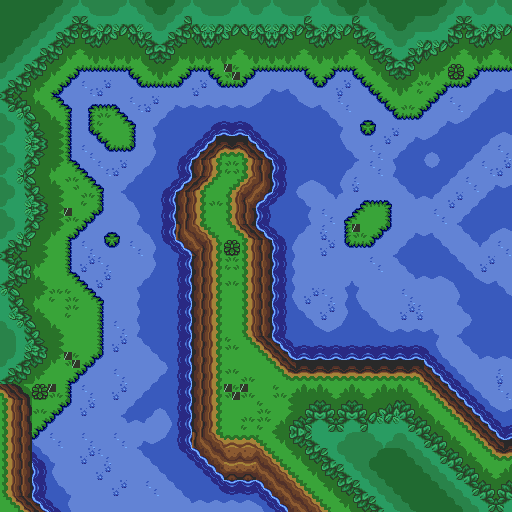 |
 |
| t-2.MAP [S-CG-CADVer1.23 901226] | Final |
|---|---|
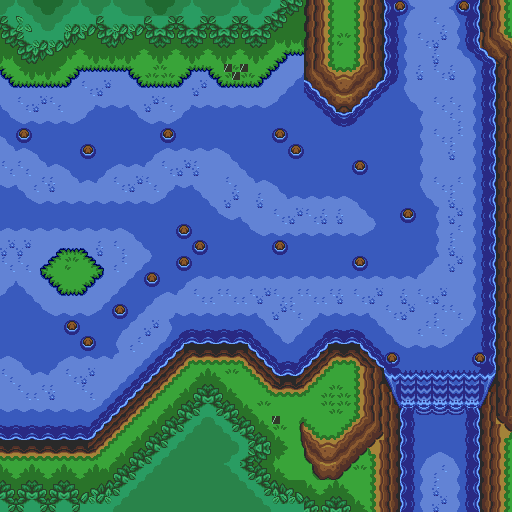 |
 |
| t-3.MAP [S-CG-CADVer1.23 901226] | Final |
|---|---|
 |
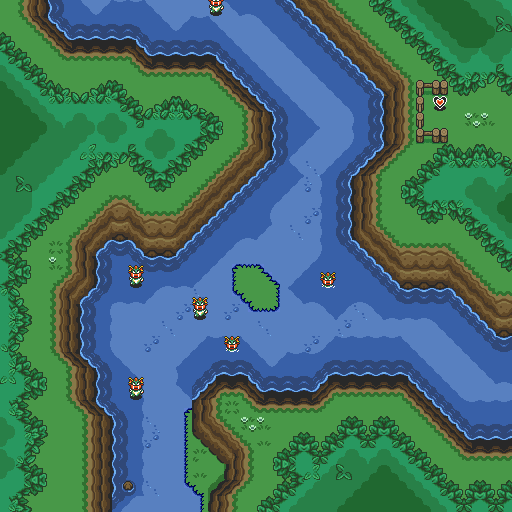 |
| t-4.MAP [S-CG-CADVer1.23 901226] | Final |
|---|---|
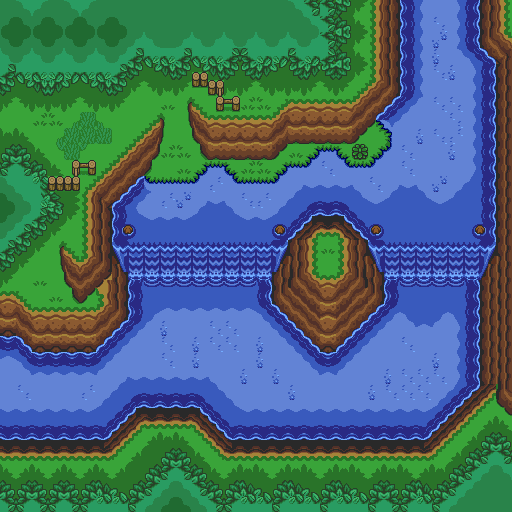 |
 |
ZF - Circa: 1991-03
The following two .MAPs don't match any area in the final game.
t-5.MAP, seen below, was last modified on 1991-03-16. It may have been an arena for the removed Zora boss battle, and come off of t-2.MAP.
| t-5.MAP [S-CG-CADVer1.23 901226] |
|---|
tt-5.MAP, seen below, was last modified on 1991-03-22.
| tt-5.MAP [S-CG-CADVer1.23 901226] |
|---|
ZF - Circa: 1991-05
| t-6.MAP [S-CG-CADVer1.23 901226] | Final |
|---|---|
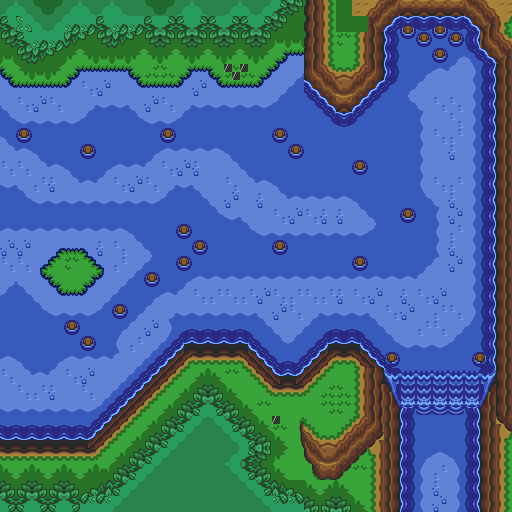 |
 |
ZF - Circa: 1991-07
The file below was last modified on 1991-07-18.
| ta1.MAP [S-CG-CADVer1.23 901226] | Final |
|---|---|
 |
 |
ZF - Circa: 1991-08
The files below were last modified on 1991-08-02.
| tt-1.MAP [S-CG-CADVer1.23 901226] | Final |
|---|---|
 |
 |
| tt-2.MAP [S-CG-CADVer1.23 901226] | Final |
|---|---|
 |
 |
| tt-3.MAP [S-CG-CADVer1.23 901226] | Final |
|---|---|
 |
 |
| tt-4.MAP [S-CG-CADVer1.23 901226] | Final |
|---|---|
 |
 |
Kakariko Village
KV - Circa: 1991-05
| e, f, g, and h.MAP [S-CG-CADVer1.23 901226] | Final |
|---|---|
   
|

|
KV - Circa: 1991-06
| Yamada Folder: Overworld Area 4 - Kakariko Village [06-20-1991] | Final |
|---|---|
 |
 |
Within the Yamada folder is an even earlier version of Kakariko Village with a last modified date of 06-20-1991. Like the previous one, the graphics file and palette file used are incorrect and there to give an idea of the layout, although the palette file does not have as many obvious flaws as the previous example. Compared to the later version of Kakariko, this one has more dirt roads and does not yet have the hedges surrounding each house, making it look less developed.
Here the idea of the well is present in the top-left, although it only has placeholder tiles when used with this graphics file and is not so close to a cliff that Link could jump into it as in the final game. The pools in the middle are more reminiscent of the Dark World's Village of Outcasts, and this idea was likely taken from here and applied there instead.
The pegs that block off the house with the overgrown front yard are still here at this earlier stage, and the left side of town has a somewhat conspicuous cabin that is out of the ordinary compared to the later versions of Kakariko.
At this stage, the weather vane did not exist at the center of town, and so this may narrow down the date when the duck that responds to the Flute was added to the game. It is, however, possible the duck merely came when you played the Flute without needing to first go through the step of playing it at the weather vane as in the final game. Judging by the earlier version of the Haunted Grove in the prototype data, where the Flute boy would normally reside, it is just as plausible the Flute boy had not yet been added to the game at this time.
KV - Circa: 1991-09
| Tanabe Folder: Overworld Area 4 - Kakariko Village [09-04-1991] |
|---|
A version of Kakariko Village with a last modified date of 09-04-1991, with no known graphics or palette files that look exactly correct. Those used here are to give an idea of the layout of the environment. Some differences include the missing well and cave, as well as the requirement to use the Hammer to enter the house with the overgrown front yard. The skulls on the roofs of some of the houses are an artifact of the graphics file used[3] which has the skulls from the fortune teller in the location where other formations could've been.
| Arimoto\Zelda\m Folder: Overworld Area 4 - Kakariko Village [09-07-1991] |
|---|
A .MAP file version of Kakariko Village with a last modified date of 09-07-1991, which is very close to the previous file with some notable differences and a better working graphics file for it. This allows one to not only roughly see what the above file would more closely look like, but it is also a useful for determining small differences from the final Kakariko Village at this time in development due to more accurate graphics.
Hyrule Castle
HC - Stamp: 1990-02
| siro.MAP [S-CG-CADVer1.11 900223] |
|---|
HC - Stamp: 1990-04
There is a nearly identical duplicate version of the later castle file below named osr-1.cgx.bak at NEWS_04\.\home\arimoto\delda\soto\. In that same directory, with the similar filename osr.cgx.bak we have a different, earlier graphic:
| osr.cgx.bak [S-CG-CADVer1.13 900424] |
|---|
Unfinished in places but clearly a castle, this asset bears an iterative name on the file above, shares similar-style wall grooves, and appears to be an older asset. Its metastamp and the tree tile used in it date the file to roughly the era of the 1990 prototype overworld. It is potentially a redesign iteration on Hyrule Castle after the one in that early 1990 overworld, but before the trees in that era of the game's development were scrapped.
As far as its palette, this particular asset, as long as the palette used is from the correct era, is relatively static - with slightly different shades of green and brown being the typical result.
HC - Stamp: 1990-12
| osr.cgx [S-CG-CADVer1.23 901226] |
|---|
The correctness of the palette for this graphics file is not absolutely certain, but when viewed in SCAD the one used here does fit many of the ancillary items we know the colors for: the village house, the grass, the trees, and the colors we would expect for one of the prototype Sanctuary revisions in the bottom-left corner of the image. The Sanctuary is depicted as having a purple motif as far back as the time when the smap.scr files were being worked on. It is also a palette that is within the same area of the data - both are in sub-directories of the delda directory.
Two factors potentially against this palette as entirely correct are the fact that the door opening animation tiles turn the doors brown (which could also be a developer oversight meant to be corrected or something that would be addressed during the animation), and that the purple doors of the main building on display here don't seem to match with the gold and pink color scheme of the rest of it.
Turning to the main building featured in the graphics file, the gold and pink color scheme here is similar to the one used for the inside of prototype Hyrule Castle, raising questions about whether the first building we see here is a revision of the Sanctuary or whether it is in fact actually a revision of Hyrule Castle.
Some factors in favor of it being Hyrule Castle are: in the early world map palette NEWS_04\.\home\arimoto\zelda\smap.col.bak, the colors of the exterior of Hyrule Castle at that stage are also gold and pink, and the curtains visible in the windows of the building match the curtains inside Hyrule Castle. At some point in 1991, Hyrule Castle was revised to move it further away from its prototype look and closer to the look we see in the final game, and these colors were minimized to the throne room.
| osr.MAP [S-CG-CADVer1.23 901226] | Final |
|---|---|

|
 
|
A partially constructed version of the castle that uses graphics very close to the final game's graphics. The idea of the courtyard also exists here but is only partly created and has much more polishing to go before it reaches the final version.
| niwa.MAP [S-CG-CADVer1.23 901226] | Final |
|---|---|
 |
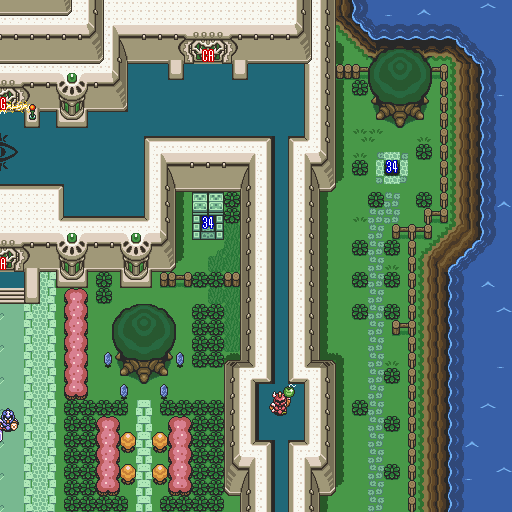 |
Though some graphical errors are present, here is a more developed version of the castle where additional changes that lead it closer to the final game's castle appear, like the second floor doorways, the fencing and a general shape that more closely resembles the final game's castle.
HC - Circa: 1991-08
| Tanabe Folder: Overworld Area 5 - Hyrule Castle [08-30-1991] | Final |
|---|---|
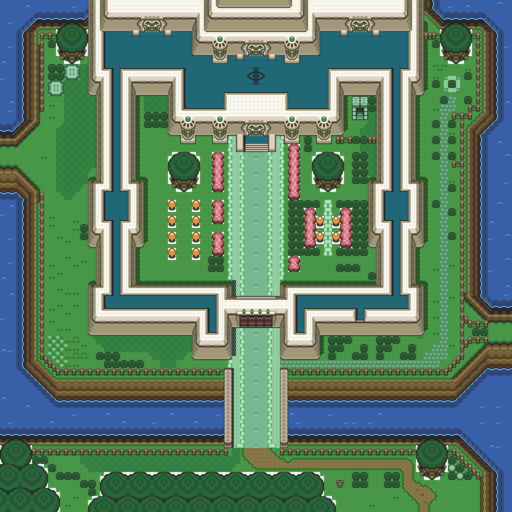 |
 |
A late, almost final Hyrule Castle from near the end of development. The main notable difference from the final game is the fence blocking the bottom-right path instead of a large rock.
Bridge to Witch's Hut
BW - Stamp: 1990-12
| s14.scr [S-CG-CADVer1.23 901226] | Final |
|---|---|
Eastern Palace
EP - Stamp: 1990-04
| hsinden.CGX.BAK [S-CG-CADVer1.13 900424] | Final |
|---|---|
 |
 |
An earlier version of the Eastern Palace entrance, fully assembled in its graphics file.
EP - Stamp: 1990-06
The Yamada folder shows a different vision for the Eastern Palace overworld area with the Triforce symbol directly on the ground in front of the entrance to the Eastern Palace itself, but currently the correct graphics files seem to be lost and would take time to recreate, if that is even possible in that case.
| 6a, 6b, 6c, 6d.scr [S-CG-CADVer1.21 900611] | |
|---|---|

|

|

|

|
EP - Circa: 1991-05
| Tanabe Folder: Overworld Area 6 - Eastern Palace [05-28-1991] | Final |
|---|---|
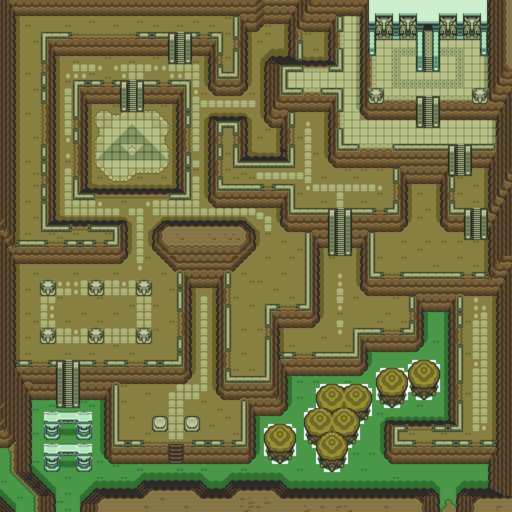 |
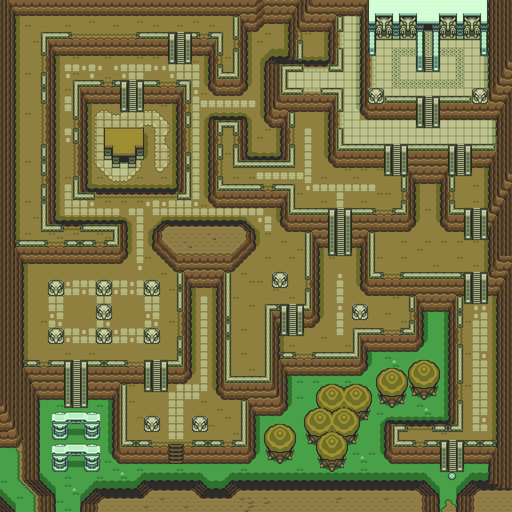 |
Exemplifying how iterative the development process was, the image on the left above is area 6 of the overworld on 05-28-1991, with there being a later version of the upper-left screen which looks much more like the final game's Sahasrahla temple (with the building not yet added) around two hours later on the same day, with the Triforce symbol on the ground being the casualty:
Haunted Grove
HG - Stamp: 1990-12
| The Haunted Grove - s19.scr [S-CG-CADVer1.23 901226] |
Final |
|---|---|
At this stage there was no tree stump here for the Flute boy to play, and instead there was a world transition tile. Whether the Flute boy existed at this stage in development is questionable.
Woods West of Link's House
WW - Stamp: 1990-12
| s20.scr [S-CG-CADVer1.23 901226] | Final |
|---|---|
Link's House
LH - Stamp: 1990-12
| s21.scr [S-CG-CADVer1.23 901226] | Final |
|---|---|
Bridge East of Link's House
BL - Stamp: 1990-12
| s22.scr [S-CG-CADVer1.23 901226] | Final |
|---|---|
The Desert of Mystery
DS - Stamp: 1990-12
| Tanabe Folder: Overworld Area 7 - The Desert of Mystery | Final |
|---|---|
 |
 |
The upper parts of the desert here are relatively late in development, with a last modified date of 10-03-1991, while the bottom parts have a metastamp of S-CG-CADVer1.23 901226 and modified dates indicating they were last in use before 05-23-1991. The more rough nature of the bottom areas show in less visual flourishes, and the fact the medallion tablet and the world transition tile that would lead to Misery Mire are not yet there. This seems to indicate not much design incorporating Dark World transitioning was put into place yet at this time compared to what there would later be. There may have been some other plan in place for how to get to Misery Mire, or it may have not yet been developed at the time of the lower portions of the desert.
Path from Swamp to Desert
SD - Stamp: 1990-12
| s29.scr [S-CG-CADVer1.23 901226] | Final |
|---|---|
Great Swamp Northwest
SN - Stamp: 1990-12
| Great Swamp Northwestern Limits - s26.scr [S-CG-CADVer1.23 901226] |
Final |
|---|---|
This area is deceptively similar in shape to its final version, but there are major differences. The world transition tile is uncovered and relatively easily accessible except for a fence. There is still a chance it is blocked off on the area to the right of this one by pegs or other obstacles, but that part of the overworld data is missing from the data in Arimoto and Watanabe's workspaces. With all these uncovered world transition tiles, it is indeed possible that perhaps the designers even at this time intended to cover some of them with rocks but left them visible in these screens for clarity purposes as to their locations.
Regarding other differences, the water pond of the final is instead a deeper pool that isn't at ground level, the rock that would block easier access to the Great Swamp on the western side is not present, and there is a large hill on the lower-right corner which was later changed over to a smaller rock outcropping.
Great Swamp Sluice Gate Ruins
SG - Stamp: 1990-12
| s30.scr [S-CG-CADVer1.23 901226] | Final |
|---|---|
It looks that at one stage in the game the player might have had to do something to open the entrance to the ruins in the Great Swamp. When using this graphic set that differs from the final game's graphics slightly, in place of stairs there is a wall or gate. It's also possible that at this stage the ruins were not intended to open but rather the player could only warp from the Dark World using the Mirror to reach this doorway and then open the water sluice gate to solve the Swamp Palace's first puzzle.
Great Swamp Southeast
SS - Stamp: 1990-12
| s31.scr [S-CG-CADVer1.23 901226] | Final |
|---|---|
Lake Hylia
HL - Stamp: 1990-06
| 32.MAP [S-CG-CADVer1.21 900424] |
|---|

|
| 33.MAP [S-CG-CADVer1.21 900611] |
|---|
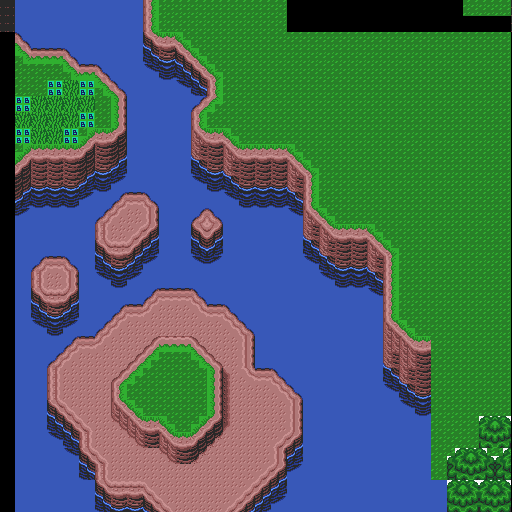
|
| 35.MAP [S-CG-CADVer1.21 900424] |
|---|
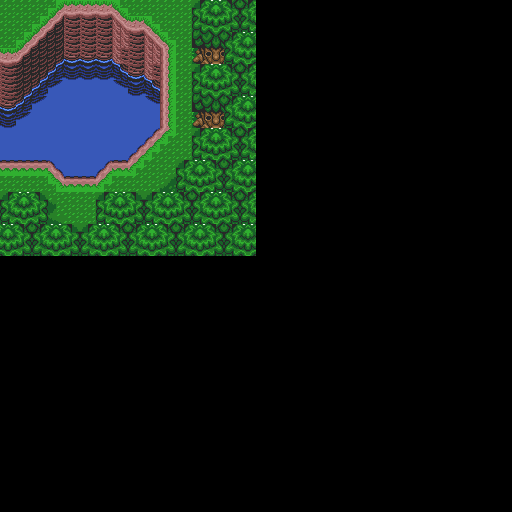
|
| 1.MAP.BAK [S-CG-CADVer1.21 900611] |
|---|

|
Of the above four images, the first three are .MAP files using a modified .PNL reconstruction technique that are reorganized so that tile formations appear logically, the third image did not require this technique. The .MAP files greatly resemble a facet of Lake Hylia, where the bridge over a snaking river drains into Lake Hylia, that has not changed even back to the 1990 era when these files date from. However, as a disclaimer, it is not 100% certain these are Lake Hylia given the relative lack of similar connecting material from this era or file name associations -- only more likely than not.
HL - Circa: 1991-09
| 8a.MAP [Last Modified: 1991-09-09] | Final |
|---|---|
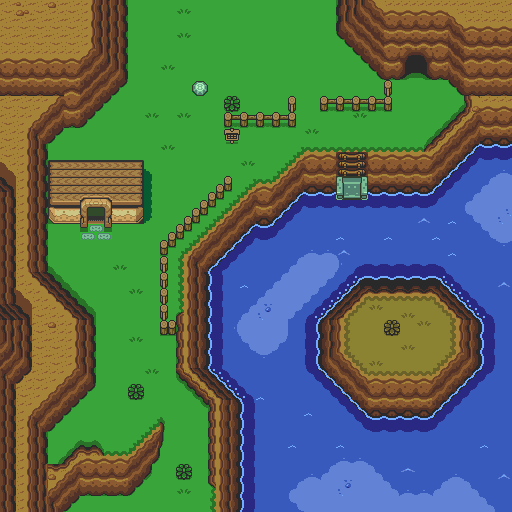 |
 |
HL - Circa: 1991-10
| Tanabe Folder: Overworld Area 8 - Lake Hylia [10-05-1991] | Final |
|---|---|
 |
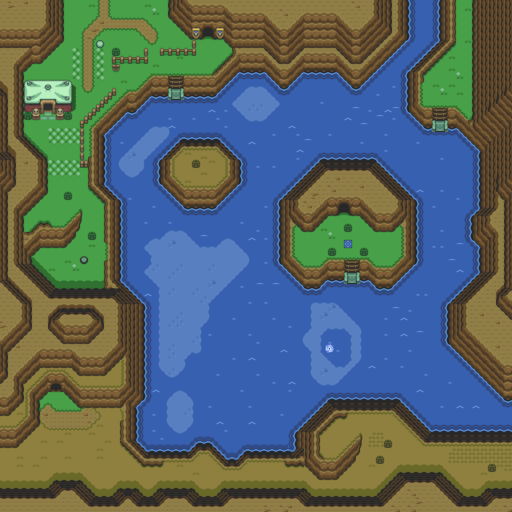 |
Lake Hylia may call into question the expectation that late modified dates on the environment (SCR) files would necessarily mean little or no difference from the final game. Early October should be very late in development, yet there are still quite notable differences from the final game here. For those who don't recall Lake Hylia well it may be less obvious, but there are some interesting things missing. The hut with the skulls at its entrance that is in the final game is missing, and the cave at the upper shore is not present either.
Missing caves and entrances is a common theme with maps in the Tanabe folder, so it is perhaps possible these are outlines of the areas with a focus on important entrances and dungeons and a design process was in place to pass them over to another designer who would then add less critical caves and entrance points where appropriate afterwards.
As far as other differences, the grass near the wall that can be blown open with a Bomb in the bottom-left corner is tiled less obviously so that it does not give any hint there may be something there, although we can't be sure if the wall is still intended to be able to be broken down there at this point or not. There is also a landing for Link to come out of the water on the island with the browning grass and single bush instead of at the final game's more convenient location at the shore on the upper-right.
Alternatively, given the 8a.map file from 1991-09-09, it could be that these 1991-10-05 screens simply have an inaccurate last modified date for some reason, because the hut and cave are present at 1991-09-09 and the final game, while missing in the 1991-10-05 screens.
Dark World
While full Dark World environment screens are rarer than Light World ones, ones like the Village of Outcasts, Dark World Fortune Teller, and Ruined House show evidence their naming became similar to Light World ones. To separate them from the Light World environments, they were prefixed by "u" (for example "u4a" and "us15"), standing for "ura."
Skull Woods
SW - Stamp: 1990-12
| mo.CGX [NAK1989 S-CG-CADVer1.23 901226] | Skull Woods Dungeon Main Entrance (Final) |
|---|---|
Early versions of the Dark World Forest tiles are present in this tilesheet. Notable are the alternate Skull Woods dungeon entrances. The entrance to the last area of the Skull Woods dungeon is smaller in the prototype data and rather different, but still recognizable as an earlier form of the idea that became the final version of the entrance.
Palace of Darkness Grounds
PD - Stamp: 1990-12
| sin.cgx [S-CG-CADVer1.23 901226] | Graphic elements of sin.cgx inserted into the final game environment |
Final |
|---|---|---|
Sin.cgx is a prototype version of the tileset for the region outside of the Palace of Darkness. The tileset itself on the left does not look like much because it does not have any fully assembled, easily visible assets. However, if its unique elements are inserted into the final game's environment data to illustrate what its assets look like when assembled, the result is a striking and different atmosphere compared to the look of the area in the final game. The final game's look is also shown for comparison.
Swamp Palace Entrance
SP - Stamp: 1990-12
| Swamp Palace Entrance - s30.scr with ho.cgx and ho.col [S-CG-CADVer1.23 901226] | Dark World Swamp CGX File (Ho.cgx) [S-CG-CADVer1.23 901226] |
|---|---|
In certain areas where the Dark World does not differ from the Light World in its environment layout, Dark World graphics overlay Light World screens exactly and leave no major graphical problems, indicating that a unique Dark World environment (.scr) file was not strictly necessary in these locations. One such case is in the Dark World Swamp Palace entrance. Here the s30.scr Light World scr file is used to show off the Dark World environment files. While the Palace itself has near-final graphics, the pillars outside it are closer to their Light World counterpart pillars, but subtly different.
There is also an unused, earlier version of the Swamp Palace entrance in the upper-right corner of the graphics (CGX) file. Unfortunately, in this case it is not pre-assembled by the developers as in the case of the prototype Skull Woods entrance earlier in this article, so it is more difficult to imagine what exactly it was intended to look like.
Fortune Teller
FD - Circa: 1991-09
| Dark World Fortune Teller - us6.scr [09-05-1991] |
|---|
One of the few Dark World environments that has an extant environment file. Unfortunately, it is from late in development and only fits exactly with what are finalized or nearly-finalized Dark World graphics files.
Ruined House
RH - Circa: 1991-09
| Ruined House - us15.scr [09-05-1991] |
|---|
This Dark World environment is in the middle of being reworked into the final game's graphic set. The tiling errors present near the path and the bushes correspond to the "dug up ground" formation in earlier Dark World tilesets, and a few of them become dug-up ground in the final game as well. The area palette had also not yet been reworked to accommodate the ruined house, and large stones had not yet been placed to block access to the area until the player has the Titan's Mitt.
Village of Outcasts
VO - Circa: 1991-09
| Dark World Area 4 - Village of Outcasts |
|---|
Another unique Dark World environment that was approaching finalization. It has obvious tiling errors, but works somewhat with the late Dark World village graphics file in Watanabe's folder named "Ura" (a term closely associated with the Dark World in the developer workspaces). Like with Kakariko Village, any skull above the entrance to a house is an artifact of the graphics file used and is not representative of what would be there at the time. The last modified dates on these SCR files are from roughly 09-05-1991 to 09-07-1991.
View of Death Mountain from Pyramid of Power
PP - Circa: 1990-12
| Dark World Sky from y-1f.CGX.BAK [09-09-1991] | Dark World Sky from pir.CGX [S-CG-CADVer1.23 901226] |
|---|---|

|
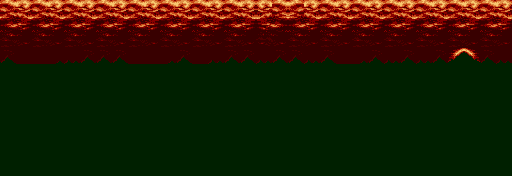
|
PP - Circa: 1991-10
It's also worth noting that the view of Death Mountain visible from the Pyramid of Power in both the final game and one version of it found in these files is incongruous to the pre-"cloudy" Death Mountain setup if the Dark World's Death Mountain is assumed to match up closely to its Light World counterpart. As one can see, there is nothing above the Tower in the view below, dating this view to later in development, as its last modified date of 09-26-1991 also attests:
| Pyramid.CGX [10-15-1991] with Sora.scr [09-26-1991] |
|---|
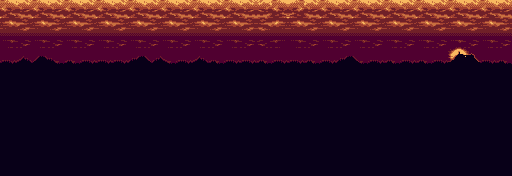
|
However, at locations NEWS\テープリストア\NEWS_04\.\home\arimoto\tanabe\y-1f.CGX.BAK and NEWS\テープリストア\NEWS_04\.\home\arimoto\tanabe\pir.CGX other older versions of this twilight scenery of the Dark World have been found in the data as well, lending credence to the idea that Ganon's Tower was not always going to be visible on the view of Death Mountain from here. Below are two other images of the same scene reconstructed from those files in the prototype data, but they also lack the obvious Ganon's Tower presence. The file y-1f.CGX.BAK has an accurate modified date of 09-09-1991 associated with it - slightly earlier than the versions of the sky in line with the final game: Sora.scr's 09-26-1991 and Pyramid.CGX's 10-15-1991. pir.CGX is an even earlier version that appears to have been created before 05-23-1991.
Here is an in-game comparison with the backgrounds inserted into the final game:
| Dark World Sky from y-1f.CGX.BAK [09-09-1991] |
Final |
|---|---|
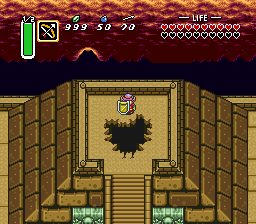 |
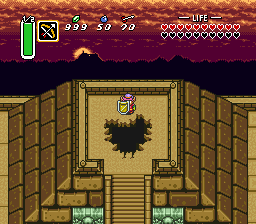 |
| Dark World Sky from pir.CGX [S-CG-CADVer1.23 901226] |
Final |
|---|---|
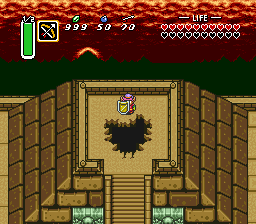 |
 |


